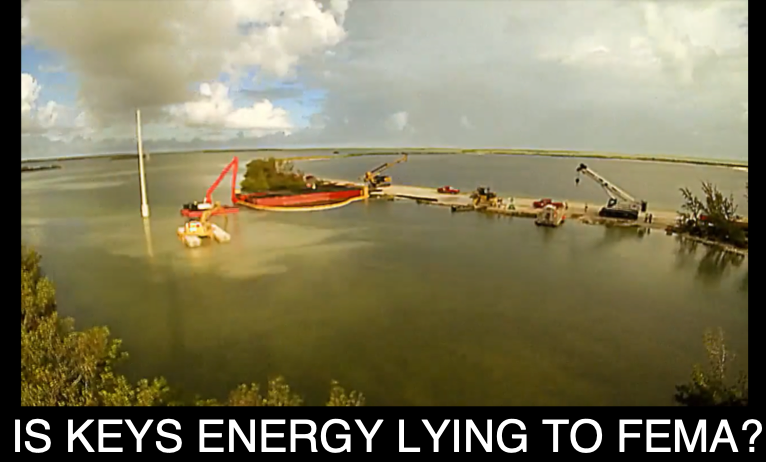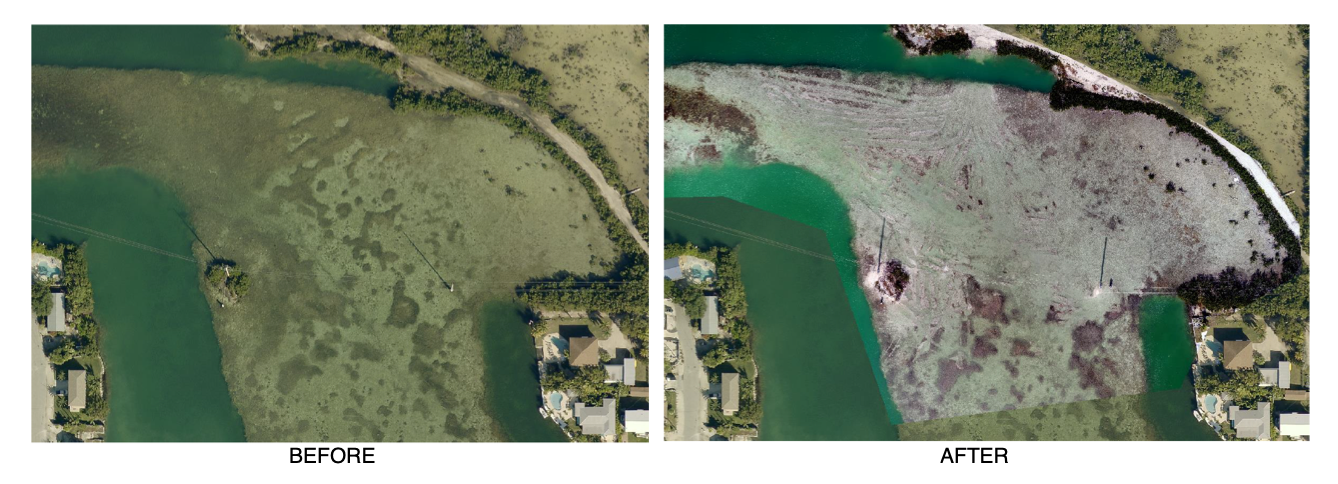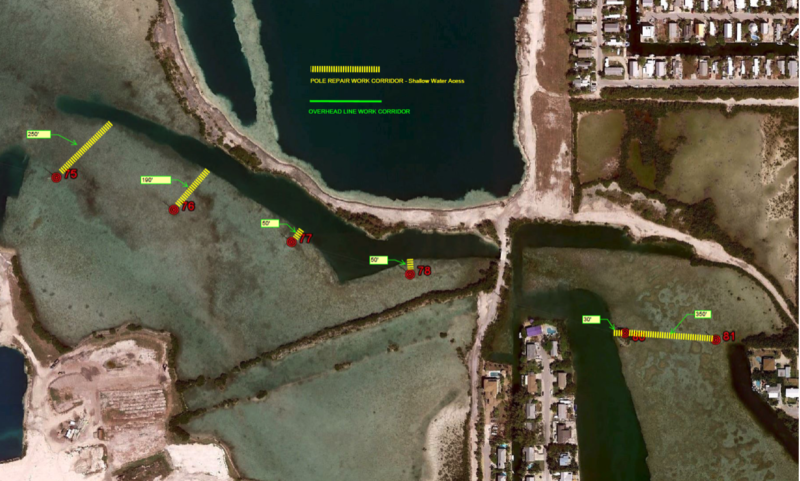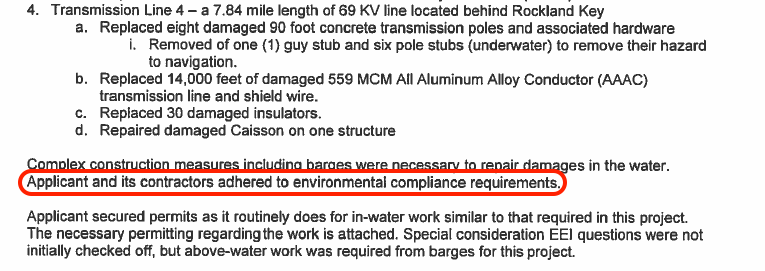IS KEYS ENERGY LYING TO FEMA?
by Arnaud and Naja Girard
This began as an environmental mystery. The images appearing on our computer screen were puzzling: they showed the before and after aerial photos of a ravaged seagrass meadow now turned into an ugly mud bank.
“Do you see the tracks?” asked the man at the other end of the phone.
We zoomed in on the high definition aerials he was sending us: What we saw looked like bulldozer tracks looping around in every direction and intersecting on the shallow banks as if a tank battle had taken place.
“Yes, we see the tracks.”
Our caller poorly disguised his emotions. For 42 years biologist, Curtis Kruer, has been working to protect Florida Keys resources and seagrasses. His work mapping boating impacts to shallow seagrass is used to monitor and manage this fragile habitat.
On September 10, 2017 the 130 mile per hour winds of Hurricane Irma, or possibly even a tornado, knocked down four electricity transmission poles and severely damaged three others near Rockland Key.
“What you see here,” says Mr. Kruer, “is the damage made by the utility contractor who repaired the line. They just let those guys loose on the seabed. There’s 20-25 acres of damage here – something we haven’t seen in the Keys in decades.”
After some quick research we found that the initial repair permit issued by the Army Corp of Engineers to Keys Energy Services required the use of “shallow draft work boats” only to be operated at high tide, and that there be “no impacts to the seagrass.”
Michels Power, one of the largest utility contractors in the U.S., had replaced seven electric poles off Rockland Key’s Line 4 at a cost of over 4-million-dollars.
We decided to look into it.
Neither the Florida Department of Environmental Protection (DEP) nor the Marine Sanctuary responded to our public records requests because the investigation was “still open.”
Keys Energy however sent us copies of over 400 emails and documents. Here we found the entire history, from the issuance of the first “no environmental impact” permit to the discovery of broken commitments.
The most dramatic piece of information came after we found an email containing this cryptic sentence: “The video was taken down at the request of Michels.”
So… there was a video on the web?
In fact, there was a video on Youtube but it was locked behind a hidden URL. When we were finally able to play it back it showed a damning account of what had happened. It was a time lapse of the worksite showing large hydraulic excavators mounted on tank-like caterpillars crawling around the seagrass meadows and stirring up clouds of mud.
The permit required the contractor to use only specified narrow pathways, going from each pole straight to the nearest deep-water:
Keys Energy did not share the infamous video [below] with investigators when responding to the Army Corp’s and the Sanctuary’s formal inquiries. [Formal response here.]
Observers Could Not See
A disturbing fact is that while the repair work was occurring local officials, including law enforcement tasked with protecting the environment, were on site, apparently witnessing the breach of the permit and environmental laws, but said nothing.
By compiling a time log of all visits by agents of all the agencies involved, we were able to establish that each work day there was at least one outside observer witnessing Michels’ destructive construction methods.
On October 12th, 13th, and 24th, 2017, biologist Phil Frank, Keys Energy’s hired environmental consultant, was onsite observing the work. Frank was the one who negotiated the permit, promising the use of designated narrow pathways; a method that was supposed to guaranty that no more than 0.44 acres of seagrass would be impacted. Frank never reported on the reckless methods being used right in front of him.
Florida Fish and Wildlife Conservation Commission (FWC) officials also made visits to the site. On October 16th they even flew overhead in a helicopter, which likely gave them the best possible view of the damage being done.
Keys Energy had also hired a monitoring company: Leidos Engineering LLC. Each day a Leidos inspector stood by and methodically listed the number of workers on site, what equipment was being used and problems observed.
On October 30th Dale Finigan was on site. At the time Mr. Finigan was Keys Energy’s Director of Engineering and the person who had authorized the 4-million-dollar contract with Michels Power. The next day, in an email to Michels’ senior manager, Finigan discussed his observations about the progress of the work.
The record shows that everyone from law enforcement to environmental consultants and parties directly involved with the construction permit had witnessed what was going on.
Seagrass beds are specially protected in the Keys. According to Pamela Reynolds, Ph.D, a single acre of seagrass can produce 10 tons of leaves a year, providing food for marine life, nursery areas, and can support as many as forty thousand fish and fifty million small invertebrates.
Yet none of the people entrusted with protecting this essential habitat ever reported the blatant violation of the permit or even tried to enforce the law.
Accountants Could Not Count
The lack of accountability is not limited to environmental issues. It also extends to the financial aspects of Keys Energy’s relationship with Michels Power.
When we interviewed Keys Energy representative, Julio Torrado, we asked whether the 4-million-dollar quote for the replacement of just seven power poles on Line 4 was higher than normal. Torrado said yes. “It was more than on a regular day… more than it would be, you know, on a sunny October day.” The higher cost, he said, was justified because of the emergency situation.
Yet when we asked how many customers were left without electricity due to Line 4 being shut down, we were told there were none. In fact, Mr. Torrado told us that electricity had been restored to all Keys Energy customers within 20-25 days of Hurricane Irma’s passing, which is about one and a half months before the Line 4 repairs were completed.
Line 4 is an old transmission line used only as a back-up. It loops into the backcountry and comes back to join the main transmission line on US 1 at the entrance of Stock Island without distributing electricity to any customers.
So why did Keys Energy accept the 4-million-dollar “emergency” rate from Michels if there was no immediate need?
A few hours after receiving an email from the Army Corps on March 2nd about the seagrass destruction at Line 4, Keys Energy’s Dan Sabino began to have doubts. He questioned an invoice showing $225,000 for 1000 man hours that Michels Power claimed were expended for environmental protection: “Does Michels have support for that?” he asked in an email to colleague Sandy Brown. Apparently, that issue was not pursued, and that line item was paid in full in spite of the resounding failure to protect the environment.
Law Enforcement Forgot the Law
 Only on one occasion, during the month long operation, did any official take a stand for the environment. Sanctuary Resource Protection and Permit Coordinator, Joanne Delaney, shut down the project shortly after the machinery arrived on scene, questioning the company’s intended “means and methods.” That was on the 11th of October.
Only on one occasion, during the month long operation, did any official take a stand for the environment. Sanctuary Resource Protection and Permit Coordinator, Joanne Delaney, shut down the project shortly after the machinery arrived on scene, questioning the company’s intended “means and methods.” That was on the 11th of October.
That same day Keys Energy‘s hired environmental consultant, Phil Frank, countered that Michels would be imposing an $88,000 per day additional cost for any permitting delays.
On the 12th Ms. Delaney withdrew her stop work order.
The contractor finished mobilizing the machinery, which seemed completely incompatible with the Florida Keys environment, and no one would question the contractor’s on the ground methods again — until it was all over.
Interestingly, a hot topic soon became whether there should be an after-the-fact environmental survey. Keys Energy’s Dan Sabino argued that the Army Corp permit did not require a post completion benthic survey. He responded to Sanctuary officials on December 13th stating, “Without this documentation, I believe KEYS will be unable to seek reimbursement from FEMA; and therefore, I will be unable to authorize the survey.”
Ultimately Keys Energy was required to go ahead and provide the infamous benthic survey to the Sanctuary and the Army Corp.
Lawyers Could Not Read Contracts
This is how the contract defines contractor liability: “Permit violations or environmental damage caused by the Contractor shall be mitigated or repaired by the Contractor, at the Contractor’s expense, to the satisfaction of the governing authority citing such damage.” It also says, “The vendor shall be responsible for any fines, penalties, damage, or assessments made against the Vendor or KEYS resulting from the performance of this contract by or on behalf of the Vendor.”
Yet in some 400 emails between government entities and Keys Energy the contractor’s liability under the contract is never directly addressed. Better yet, in a March 5, 2018 email, Steve Werndli, NOAA’s enforcement and emergency response coordinator, suggests that Keys Energy should ask FEMA to pay for the seagrass restoration on Rockland Key.
Lying to FEMA
And from there things get even more puzzling.
By April 25, 2018 Keys Energy had completed its FEMA application asking for 75% reimbursement of the over 4-million-dollars in so-called “emergency” repairs to Line 4. In that application Keys Energy was required to certify compliance with environmental laws and permits.
To be clear, On March 2, 2018, after receiving the benthic survey showing over ten acres of seagrass destruction, Robert Kirby of the Army Corp of Engineers enforcement section sent Keys Energy a scathing email about “permit compliance concerns about the repair work that occurred at Line 4.” The email mentions the severe damage done to the seagrass bed and the violation of the Army Corp permit that required use of “shallow draft work boats.” Kirby’s email was immediately followed by another, with similar concerns, from NOAA (Sanctuary).
The March 2018 emails from the Army Corp and NOAA clearly put into question the issue of compliance with environmental laws and the permit for the Line 4 repairs. But Keys Energy went ahead and certified to FEMA in their request for reimbursement that: “Applicant [Keys Energy] and its contractors [Michels Power] adhered to environmental compliance requirements.”
At every turn it seems that all parties involved went out of their way to favor and protect giant utility contractor, Michels Power:
- Keys Energy agrees to pay Michels Power an emergency rate for what was, arguably, non-emergency work.
- Everyone is turning a blind eye while witnessing the blatant violation of environmental laws and permit requirements.
- Keys Energy chooses to be untruthful on its FEMA reimbursement application rather than to hold Michels to its contractual liability.
Where Does it Go From Here?
Officially, the massive seagrass destruction near Rockland Key is still “under investigation” by the Sanctuary and DEP. Phil Frank, who conducted the post construction benthic survey on behalf of Keys Energy, found about 10.5 acres was damaged, but biologist Curtis Kruer believes upwards of 20 acres was impacted. The investigation has been open for almost a year and a half with no end in sight.
However, there are indications that the parties involved see a benefit to sitting on their hands. In an August 24, 2018 email, Frank mentions that Sanctuary officials are on slow mode regarding the investigation. He wrote to Keys Energy: “The longer it lingers the more the area recovers. Unless you have a better strategy, I’d say we continue to work with FKNMS [Sanctuary] at their pace and schedule. Keep the ball in their court, be responsive but not necessarily push them for a fast resolution.”
As to the Army Corp, the Jacksonville branch has been ordered not to pursue enforcement of Michels Power’s permit violation. Robert Kirby wrote in an April 30, 2019 email that the decision came down “through the chain of command.”
With the Sanctuary in “slow mode” and the Army Corp ordered to stand down, it doesn’t look as though anyone is ready to tackle giant post-hurricane contractors anytime soon.
In the meantime, Michels Power and Keys Energy, just last month on May 22nd, entered into a new pre-approved emergency response contract for the 2019 hurricane season.
Keys Energy is still unclear about its environmental responsibilities: After the disaster at Rockland Key, one Keys Energy employee still had questions about instructing a new contractor on Line 4. She emailed the following questions to Phil Frank: “Should I give them a map of where they can go and not go. Like deep water then into pole and back out same way. Can’t cross pole to pole? Or – delete the email and forget you know anything about it?”
Whether FEMA will agree to reimburse the over 4-million-dollars paid to Michels is an open question. FEMA could refuse to pay, either because the contractor violated environmental laws or because Keys Energy lied about environmental compliance on the reimbursement application.
Lower Keys residents might find themselves on the hook for millions of dollars payable through their electric bills.
“You know,” said Curtis Kruer, “when I first came across those aerial photos, I emailed Gus Rios, (Regional head of DEP – Marathon). His answer was a little odd, something like, ‘Thank you for the information. We will be looking into it.’ He was acting as though he didn’t already know. But, that’s at least 20 acres of destruction, something we haven’t seen in decades. How could he not know?… Damage to the sea bed used to be taken very seriously.”
In 1997 treasure hunter Mel Fisher’s company was made to pay $562,778 for destroying seagrass while looking for shipwrecks in the Keys.
According to Mr. Kruer, whose company, Coastal Resource Group, authored a 2015 study, the average cost of seagrass restoration today in the Keys is approximately $1 million/per acre.
“They think the seagrass is going to grow back quickly on its own? It’s not,” says Mr. Kruer, “It takes decades.”
DID YOU LIKE THIS STORY?
HELP KEEP LOCAL INDEPENDENT JOURNALISM ALIVE…
TO MAKE A MONTHLY OR A ONE-TIME VOLUNTARY CONTRIBUTION
CONTRIBUTE:Become a “Patron” by signing up to give monthly support on Patreon by clicking on the orange button below:
OR
Use PAYPAL or your Credit Card
to give either monthly
or
a one-time donation
by clicking on the button below:
[You will be sending money to Blue Pimpernel LLC [dba Key West The Newspaper]
NOTE: CONTRIBUTIONS ARE NOT TAX-DEDUCTABLE
![]() or if you have a PAYPAL account you can always use this link to send any amount you choose:
or if you have a PAYPAL account you can always use this link to send any amount you choose:
https://www.paypal.me/thebluepaper
or send check or money order made out to:









Dear Naja & Arnaud,
Another litany of government agencies, bureaucrats and statists that the government has put together for our protection; which has not worked. Nothing has changed. Government failed projects and sponsored destruction continues to litter the decline of many nations and civilizations.
Yet, some people fixate upon government to protect them and solve their problems. These conditioned and propagandized adherents to the sanctity of the Administrative State, are unable to bear up under the fact that individual creativity, integrity and commitment to excellence are the only forces capable of uplifting one’s society, culture and the world at large.
Fanciful delusions and feel good fantasies are entertaining talking points, however, they get no real traction on the firing line of life, where the rubber meets the road.
The last guest column I submitted, which you chose not to publish, specifically addressed the reasons why the citizenry has gotten, and will continue to receive neglectful malfeasance from those entrusted with their care.
I’ve taken my Sell-Actualization and Self-Realization scholarship programs, which the Monroe County School System refused to add to their curriculum as an elective, at no cost to the taxpayer, to the Mainland.
As a Teacher I incorporated many elements of these programs with my students during the course of my career. Everyone exposed to these principles, has utilized them to improve their lives and the lives of all in their Orbit. These citizens with an enlightened wisdom and knowledge will fill the positions of those that are currently denigrating our environment and poisoning our fragile aquatic egosystem. Even old crusty adults can uplift their consciousness and be catipulted into another dimension, whenever they want to.
My Friends, you can talk and write until you’re blue in the face; nothing is going to change… Until the Consciousnesses’ , Awareness’s and Attitudes affiliated with those involved in the decision making process; Change. As you know, Insanity is doing the same thing over and over again, expecting different results.
We can never surrender our Individual Right of Self-Determination to a Powerful, Self-Serving and Unresponsive Force; and expect to be treated Responsibly…
Blessings & Respect… Always
Hi, thanks for this story. The photos show that the pontoon backhoe drove all over the seagrass as if it didn’t care or know anything about the environment it was supposed to protect. Then Keys Energy lied to FEMA to get reimbursed for the cost of replacing the poles. they lied to get three million dollars reimbursement. They said the repairs were done with environmental sensitivity. Why did they lie? Because they could. Corporate underlings are protected by law from going to jail for criminal performances. Occasionally the corp will get a fine whih its customers will have to pay. How long can this insanity last? Some say we are in the end times and they are right because corporations are lying theiir way out of taking responsibility for the carnage they aare causing the global environment.
pack your own chute!